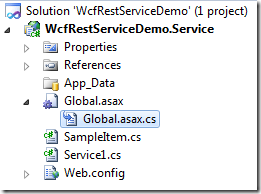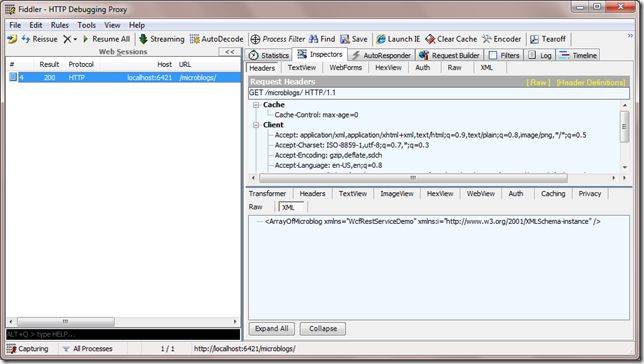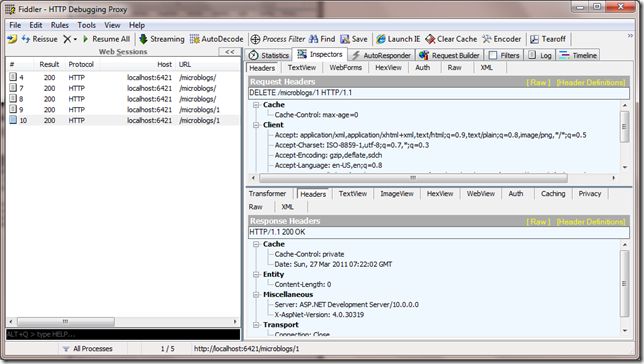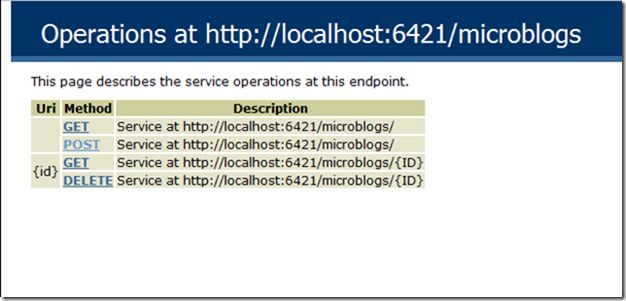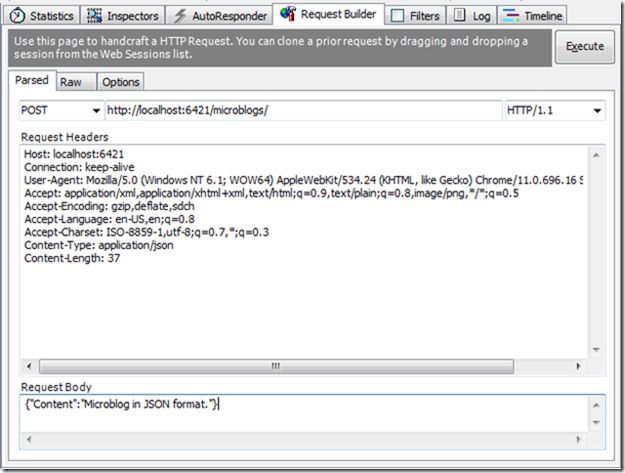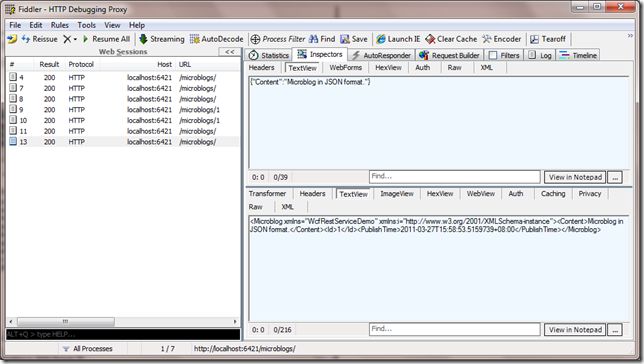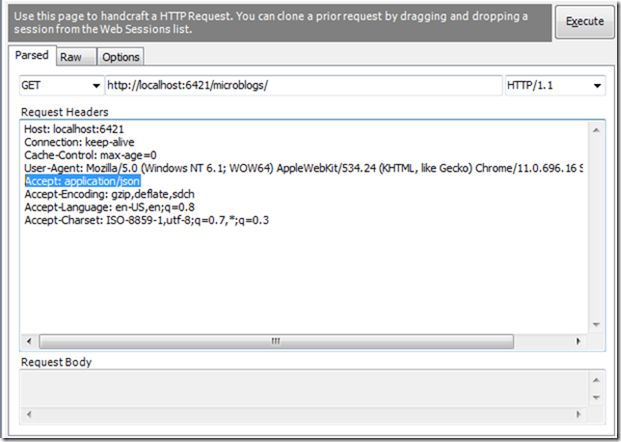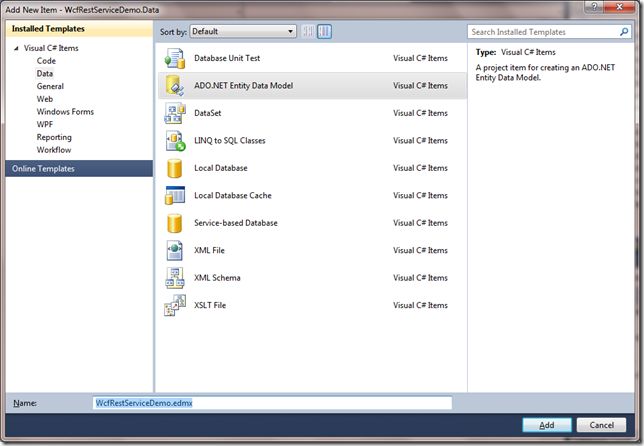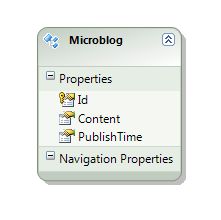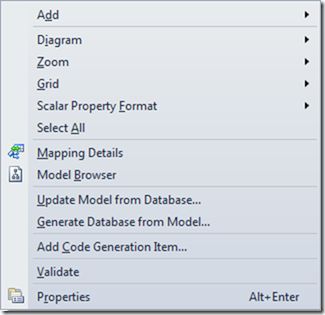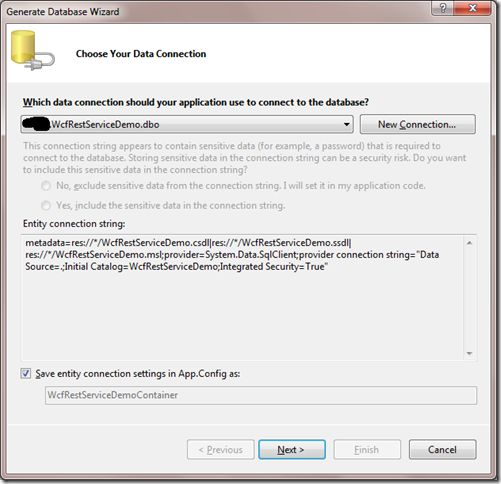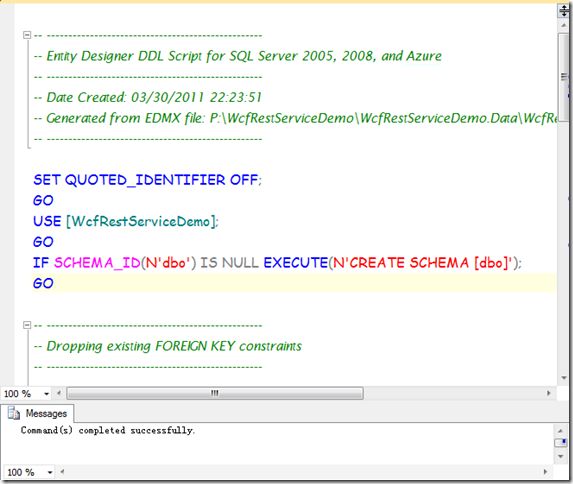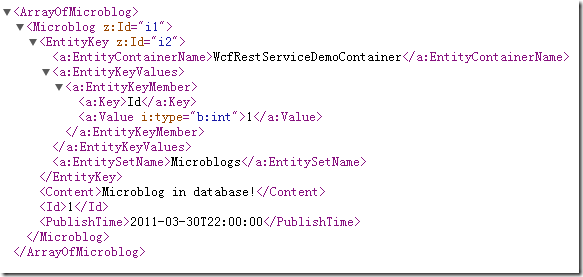<add name="WcfRestServiceDemoContainer"
connectionString="metadata=res://*/WcfRestServiceDemo.csdl|res://*/WcfRestServiceDemo
.ssdl|res://*/WcfRestServiceDemo.msl;provider=System.Data.SqlClient;provider connection
string="Data Source=.;Initial Catalog=WcfRestServiceDemo;Integrated Security=True;
MultipleActiveResultSets=True""
providerName="System.Data.EntityClient" />
我的WCF4 Rest Service及Entity Framework with POCO之旅
(一)——创建一个基本的RESTful Service
很久没有玩WCF了,年前和几个朋友做一个Restful的服务,惊讶于WCF4已经能如此完美实现REST(好吧,我承认不是完全完美)。期间遇到了许多难题,但还是一一解决,或者找到了workaround. 为了让以后想做同样事情的朋友不至于像我们这般抓狂,也为了给自己整理一下所学,我准备写一个系列,讲述如何从零开始创建一个完整的支持Token验证的REST服务,其内容将涉及如何控制返回内容格式,如何处理异常并返回自定义内容,如何建立基于token的身份验证,如何使用POCO,如何做service的单元测试……总之,总之,看了就知道了。鉴于文笔拙劣,技亦不精,不敢和大牛比肩,姑且自称为《我的WCF4 Rest Service及Entity Framework with POCO之旅》吧,还请各位高手多多指教。
照理说,首先应介绍什么是REST,它是怎么出现的,有什么优势,什么历史意义。不过我不多想讲,也讲不清楚。简而言之,REST最核心的概念是“资源”,一个uri代表一个特定的资源,而客户端通过HTTP method GET, POST, PUT, DELETE来和资源交互(同时导致状态转移)。至于资源的表现形式,则以XML和JSON为主。为什么要用REST? 自己想去吧。
创建项目
闲话说完,现在开始创建项目。使用Online Templates中的WCF REST Service Template是一个比较容易的方法:
项目创建好后,我们可以看到项目中已经有下面这些文件:
Service1就是一个WCF Service,和以前的WCF Service不同,这里的Service既不是一个.svc文件,也没有专门定义一个接口作为ServiceContract。
SampleItem就是我们以往所知的DataContract,不过现在即使不加DataContract attribute,也没有关系。
比较特别的是Global.asax和Global.asax.cs。Global.asax.cs中定义了Routes:
private void RegisterRoutes()
{ // Edit the base address of Service1 by replacing the "Service1" string below RouteTable.Routes.Add(new ServiceRoute("Service1", new WebServiceHostFactory(), typeof(Service1)));}
表示所有访问HOST/Service1的请求都要由Service1这个类来处理。再看一下Service1的定义,其中有个方法是:
[WebGet(UriTemplate = "{id}")]
public SampleItem Get(string id)
{ // TODO: Return the instance of SampleItem with the given id throw new NotImplementedException();}
这表示对于HOST/Service1/123的GET请求,将会用这个Get(string)方法来处理。服务运行时,WCF根据uri中的“Service1”根据前面指定的Route找到Service1这个服务类,再根据UriTemplate,将“123”赋给名为id的参数,其结果就是Get方法以参数“123”被调用了。
现在我们修改一下这个方法,让它能够返回结果:
[WebGet(UriTemplate = "{id}")]
public SampleItem Get(string id)
{ return new SampleItem { Id = int.Parse(id), StringValue = string.Format("The id is {0}.", id) };}
然后启动这个服务。在浏览器地址栏中输入“http://localhost:6421/Service1/123”(端口号根据实际情况而定),结果如下:
如何,是不是很简单?
不过现在的RESTful服务还只能读取资源,WebGet只支持GET方法,要支持PUT, POST和DELETE,需要使用WebInvoke attribute。而且,现在的服务看不出任何实际意义。
既然掌握了基本技术,我们来创建一个稍微有点实际意义的服务
创建一个简易微博服务
(终于不是做图书管理系统示例了)
首先,我们的微博服务真的很简单,简单到只能有一个用户自娱自乐,而且还只能发文字,是不是有点无聊?不过不要急,一步一步来。
既然如此,所谓的微博服务,也就是一个微博管理系统了(…)。它应该有这些功能:
发布微博
查看已发布的微博
删除一条微博
照此删去原先那些示例代码,重新编写代码如下:
using System;
using System.Collections.Concurrent;
using System.Collections.Generic;
using System.Linq;
using System.ServiceModel;
using System.ServiceModel.Activation;
using System.ServiceModel.Web;
using System.Threading;
namespace WcfRestServiceDemo.Service
{
[ServiceContract(Namespace = "WcfRestServiceDemo")]
[AspNetCompatibilityRequirements(RequirementsMode = AspNetCompatibilityRequirementsMode.Allowed)]
[ServiceBehavior(InstanceContextMode = InstanceContextMode.PerCall)]
public class MicroblogService
{
private static int _currentId;
private static readonly ConcurrentDictionary<int, Microblog> _microblogs =
new ConcurrentDictionary<int, Microblog>();
[WebGet(UriTemplate = "")]
public List<Microblog> GetCollection()
{
return _microblogs.Values.ToList();
}
[WebInvoke(UriTemplate = "", Method = "POST")]
public Microblog Create(Microblog microblog)
{
microblog.Id = Interlocked.Increment(ref _currentId);
microblog.PublishTime = DateTime.Now;
_microblogs.TryAdd(microblog.Id, microblog);
return microblog;
}
[WebGet(UriTemplate = "{id}")]
public Microblog Get(string id)
{
return _microblogs[int.Parse(id)];
}
[WebInvoke(UriTemplate = "{id}", Method = "DELETE")]
public void Delete(string id)
{
Microblog microblog;
_microblogs.TryRemove(int.Parse(id), out microblog);
}
}
}
using System;
using System.Runtime.Serialization;
namespace WcfRestServiceDemo.Service
{
[DataContract(Namespace = "WcfRestServiceDemo")]
public class Microblog
{
[DataMember]
public int Id { get; set; }
[DataMember]
public string Content { get; set; }
[DataMember]
public DateTime PublishTime { get; set; }
}
}
Global.asax.cs
using System;
using System.ServiceModel.Activation;
using System.Web;
using System.Web.Routing;
namespace WcfRestServiceDemo.Service
{
public class Global : HttpApplication
{
private void Application_Start(object sender, EventArgs e)
{
RegisterRoutes();
}
private void RegisterRoutes()
{
RouteTable.Routes.Add(new ServiceRoute("microblogs", new WebServiceHostFactory(),
typeof (MicroblogService)));
}
}
}
编译并运行。
理所当然什么都没有,一条微博都还没发呢。为了方便的发送请求并查看结果,祭出神器Fiddler2:
在右边窗口可以看到请求返回的XML。
接下来选择右边上面的Request Builder,来构造一个POST:
(可以把左边那个请求拖入编辑窗口快速复制一个请求。)
(注意要在上面的Headers窗口添加Content-Type: application/xml这一项,同时注意XML的namespace。)
点击Execute:
服务返回HTTP 200 OK,并且可以从Response的内容中看到成功创建的Microblog的Id以及PublishTime的值。
再次获取全部:
已经可以看到刚才创建的微博了。现在再试一下其他两个功能:
获取单条微博:
删除指定微博:
再次查询全部,结果又是空空如也了。到这里,一个超级简单的“微博”服务已经搭建起来了。
(二)——选择请求/返回格式
REST被推崇,一个很重要的原因就是它的数据格式可以是XML,也可以是JSON,这使得Javascript可以轻松调用RESTful服务。WCF REST内置了JSON序列化器,可以轻易实现格式的转换,甚至可以根据请求动态选择返回的格式。
先看看如何手动指定返回格式。WebGetAttribute和WebInvokeAttribute有RequesetFormat和ReponseFormat两个属性,可以指定请求/返回格式为XML或者JSON:
但相比之下,动态选择格式还是更灵活也吸引人一些。打开之前创建的项目,在自动生成的web.config中,有这么一条配置:
打开服务帮助就是当访问/microblogs/help时会看到如下的帮助界面:
列举了服务的接口,每个接口还说明了其详细用法、示例,以及请求/返回数据的scheme。
而自动格式选择,分为两部分:自动根据请求,选择请求内容的格式和回复内容的格式。这两者分别是通过HTTP请求头中的Content-Type和Accept这两项指定的。
在Fiddler2中把Content-Type改成application/json, 表示请求的内容格式是JSON,再次发布一条微博:
请求成功,可以看到请求内容是JSON格式,服务器成功处理了,但返回还是XML格式:
现在再修改Accept头为application/json, 表示只接受JSON的返回格式,然后获取所有的微博:
结果如下:
可以看到,返回内容已经是JSON格式了。等等,那个时间的格式好像有点怪?另外,大写的field名称似乎也不合习惯。别急,我们以后会解决这些问题。
(三)——用Entity Framework和POCO Template实现数据模型及存储
既然这个系列标题中都含有Entity Framework和POCO,这两者若到第三篇还不出现那就太奇怪了。本文将介绍如何使用Entity Framework和POCO来实现数据模型的创建以及数据存储。
接着上文,我们现在已经有了一个微博服务。但是,一旦网站重启或者IIS重启,我们就会丢失之前所有发布的微博,这样的服务显然不是我们所能接受的,我们接下来要构建服务的数据存储。使用Entity Framework的Model-First设计方式,可以大大简化这个过程。
使用Entity Data Model创建数据模型
我们首先创建一个类库项目WcfRestServiceDemo.Data,然后添加新项“ADO.NET Entity Data Model”:
选择数据源,如果有现成的数据源的话可以从数据库导入。我们选择Empty model, 新创建数据模型。
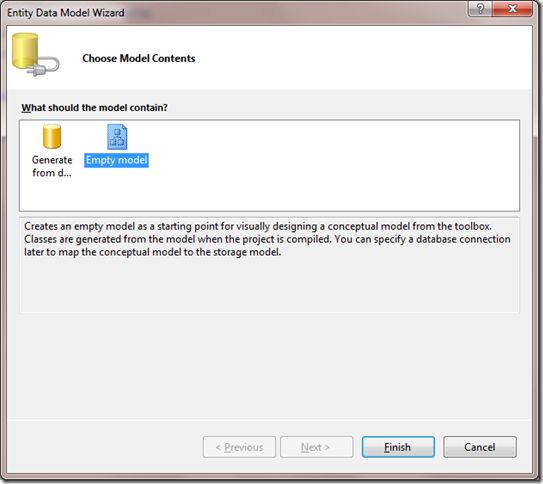
从工具箱中找到Entity,拖入设计器,参考之前创建的数据类型,修改得到:
到这里数据模型就创建完了。下面我们要把它同步到SQL Server。
由模型生成数据库
到目前为止,模型还只存在C#项目中,虽然我们已经可以写代码来操纵数据,但实际上是无法运行的(或者说一运行就会挂掉的)。
要将模型同步到SQL Server,对设计器视图点右键,选择Generate Database from Model…
选择一个连接,没有的话就创建一个:
然后对应的SQL脚本就自动生成好了:
打开WcfRestServiceDemo.edmx.sql,右键选择Execute SQL,成功后模型就同步到SQL Server了
修改服务代码
现在数据模型和数据存储都做好了,我们要修改服务代码来使用新的数据模型。
删去Microblog.cs,添加对WcfRestServiceDemo.Data和System.Data.Entity的引用,并修改MicroblogService.cs代码如下:
using System;
using System.Collections.Generic;
using System.Linq;
using System.ServiceModel;
using System.ServiceModel.Activation;
using System.ServiceModel.Web;
using WcfRestServiceDemo.Data;
namespace WcfRestServiceDemo.Service
{
[ServiceContract(Namespace = "WcfRestServiceDemo")]
[AspNetCompatibilityRequirements(RequirementsMode = AspNetCompatibilityRequirementsMode.Allowed)]
[ServiceBehavior(InstanceContextMode = InstanceContextMode.PerCall)]
public class MicroblogService
{
[WebGet(UriTemplate = "")]
public List<Microblog> GetCollection()
{
using(var container = new WcfRestServiceDemoContainer())
{
return container.Microblogs.ToList();
}
}
[WebInvoke(UriTemplate = "", Method = "POST")]
public Microblog Create(Microblog microblog)
{
microblog.PublishTime = DateTime.Now;
using(var container = new WcfRestServiceDemoContainer())
{
container.Microblogs.AddObject(microblog);
container.SaveChanges();
}
return microblog;
}
[WebGet(UriTemplate = "{id}")]
public Microblog Get(string id)
{
using(var container = new WcfRestServiceDemoContainer())
{
return container.Microblogs.FirstOrDefault(m => m.Id == int.Parse(id));
}
}
[WebInvoke(UriTemplate = "{id}", Method = "DELETE")]
public void Delete(string id)
{
using(var container = new WcfRestServiceDemoContainer())
{
container.Microblogs.DeleteObject(
container.Microblogs.First(m => m.Id == int.Parse(id)));
container.SaveChanges();
}
}
}
}
要让Entity Framework正常工作,我们还需要把它生成的app.config文件中的ConnectionString复制到服务的web.config文件中:
这里附带一提,有的时候我们会遇到无法正确加载Model的情形,这时只要将上面那个连接字符串中的*替换成数据模型(*.edmx)所在的程序集名称(这里是WcfRestServiceDemo.Data),显式指定搜索路径即可。
怎么回事?Content, Id, PublishTime这些属性倒是一个也不少,但是也多了很多其他的东西。这是因为与POCO不同,基于EntityObject的Entity Data Model支持更改提醒、关系管理等许多其他功能,所以会包含更多的属性,只不过在我们这个应用场景中,并不需要这些支持。另一个问题是,这时默认的命名空间变成了
xmlns=http://schemas.datacontract.org/2004/07/WcfRestServiceDemo.Data
而且由于Microblog这个DataModel是自动生成的,我没有办法改它的DataContractAttribute(改了下次生成又会变回来):
[EdmEntityTypeAttribute(NamespaceName="WcfRestServiceDemo", Name="Microblog")]
[Serializable()]
[DataContractAttribute(IsReference=true)]
public partial class Microblog : EntityObject
{
…
}
要解决上述问题,我们该请出下一位主角POCO了。
使用ADO.NET C# POCO Entity Generator生成POCO模型
POCO全称Plain-Old CLR Objects(中文不知道怎么说)。以前有很多人手写POCO模型,不过现在已经有了一个非常强大的基于T4模板的模型生成器。
打开Visual Studio 2010的Extension Manager,找到ADO.NET C# POCO Entity Generator并安装(或者在这里下载):
然后打开WcfRestServiceDemo.edmx,右键选择Add Code Generation Item…:
找到刚才安装的模板:

创建结果:
Model.Context.tt和Model.tt分别是Container和Entity的T4模板。现在再运行一下服务,获取所有微博:
为什么会Empty Response? 调试一下服务,发现返回的类型不是Microblog, 而是System.Data.Entity.DynamicProxies.Microblog_C60A574FC06ABEF4672858332CE687DDE70D188AD3BD73ED2731E8854D30C927,而WCF并不认识这个类型。这是因为默认的Entity Data Model启用了LazyLoading和Proxy机制的缘故。这两个特性我以后也许会详细讲,不过目前我们只要把它们关闭就好。虽然Model设计器提供了下面这个属性可以修改:
但是当我改成False然后对Model.Context.tt右键选择Run Custom Tool 重新生成Container代码,却没有任何效果,Container构造器代码依旧如下:
如果有哪位高手知道应该如何设置,请告诉我。我们现在先通过扩展Container类的方法来解决这个问题,下一篇讲如何通过修改T4模板来改变生成的Container。
在WcfRestServiceDemo.Data中创建WcfRestServiceDemoContainer.cs,代码如下:
using System;
namespace WcfRestServiceDemo.Data
{
partial class WcfRestServiceDemoContainer
{
public static void Go(Action<WcfRestServiceDemoContainer> todo, bool isLazy = false)
{
Go<object>(entities =>
{
todo(entities);
return null;
},
isLazy);
}
public static void GoAndSave(Action<WcfRestServiceDemoContainer> todo, bool isLazy = false)
{
Go<object>(entities =>
{
todo(entities);
entities.SaveChanges();
return null;
},
isLazy);
}
public static T Go<T>(Func<WcfRestServiceDemoContainer, T> todo, bool isLazy = false)
{
using(var entities = new WcfRestServiceDemoContainer())
{
entities.ContextOptions.LazyLoadingEnabled = isLazy;
entities.ContextOptions.ProxyCreationEnabled = isLazy;
return todo(entities);
}
}
public static T GoAndSave<T>(Func<WcfRestServiceDemoContainer, T> todo, bool isLazy = false)
{
return Go(entities =>
{
var result = todo(entities);
entities.SaveChanges();
return result;
},
isLazy);
}
}
}
这里我顺便写了几个帮助方法,因为每次使用Container时写using很麻烦,关键是我经常改完数据忘记调SaveChanges().
最后修改MicroblogService.cs代码如下:
usingstyle="FONT-SIZE: 10pt" System;
using System.Collections.Generic;
using System.Linq;
using System.ServiceModel;
using System.ServiceModel.Activation;
using System.ServiceModel.Web;
using WcfRestServiceDemo.Data;
namespace WcfRestServiceDemo.Service
{
[ServiceContract(Namespace = "WcfRestServiceDemo")]
[AspNetCompatibilityRequirements(RequirementsMode = AspNetCompatibilityRequirementsMode.Allowed)]
[ServiceBehavior(InstanceContextMode = InstanceContextMode.PerCall)]
public class MicroblogService
{
[WebGet(UriTemplate = "")]
public List<Microblog> GetCollection()
{
return WcfRestServiceDemoContainer.Go(container =>
container.Microblogs.ToList());
}
[WebInvoke(UriTemplate = "", Method = "POST")]
public Microblog Create(Microblog microblog)
{
microblog.PublishTime = DateTime.Now;
WcfRestServiceDemoContainer.GoAndSave(container =>
container.Microblogs.AddObject(microblog));
return microblog;
}
[WebGet(UriTemplate = "{id}")]
public Microblog Get(string id)
{
return WcfRestServiceDemoContainer.Go(container =>
container.Microblogs.FirstOrDefault(m => m.Id == int.Parse(id)));
}
[WebInvoke(UriTemplate = "{id}", Method = "DELETE")]
public void Delete(string id)
{
WcfRestServiceDemoContainer.GoAndSave(container =>
container.Microblogs.DeleteObject(
container.Microblogs.First(m => m.Id == int.Parse(id))));
}
}
啊哈,又回到最初干净的状态了。只是Namespace问题以及属性名称的大小写问题还是没有解决,但是我们已经离目标更近一步了

